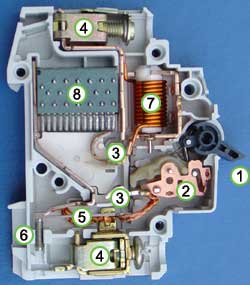Circuit breaker
Circuit breaker
A circuit breaker is an automatically operated electrical switch designed to protect an electrical circuit from damage caused by overcurrent or short circuiting. Its basic function is to interrupt current flow after a fault is detected. Unlike a fuse, which operates once and then must be replaced, a circuit breaker can be reset (either manually or automatically) to resume normal operation.
Operation[edit | edit source]
Circuit breakers are made in varying sizes, from small devices that protect low-current circuits or individual household appliances, to large switchgear designed to protect high voltage circuits feeding an entire city. The generic function of a circuit breaker, regardless of type, is to detect a fault condition and, by interrupting continuity, to immediately discontinue electrical flow.
Types of Circuit Breakers[edit | edit source]
Circuit breakers can be classified into several types based on their features and applications:
- Miniature Circuit Breaker (MCB): Used for low voltage applications, typically in residential and commercial buildings.
- Molded Case Circuit Breaker (MCCB): Used for higher current ratings and can be found in industrial applications.
- Air Circuit Breaker (ACB): Used for high voltage applications and can interrupt large currents.
- Vacuum Circuit Breaker (VCB): Utilizes a vacuum to extinguish the arc when the circuit is broken.
- SF6 Circuit Breaker: Uses sulfur hexafluoride gas to quench the arc and is used in high voltage applications.
Components[edit | edit source]
A typical circuit breaker consists of the following components:
- Contacts: Allow current to flow when closed and interrupt the flow when open.
- Arc Extinguishers: Devices that extinguish the arc formed when the contacts open.
- Operating Mechanism: Provides the means to open and close the contacts.
- Trip Unit: Senses the fault condition and initiates the operation of the operating mechanism.
Applications[edit | edit source]
Circuit breakers are used in various applications, including:
- Residential wiring
- Commercial buildings
- Industrial plants
- Power distribution networks
- Automotive electrical systems
Maintenance[edit | edit source]
Regular maintenance of circuit breakers is essential to ensure their reliable operation. This includes:
- Visual inspection for signs of wear or damage.
- Testing the trip unit to ensure it operates correctly.
- Cleaning and lubricating moving parts.
- Checking and tightening electrical connections.
Related Pages[edit | edit source]
- Fuse (electrical)
- Electrical wiring
- Power distribution
- Electrical engineering
- Short circuit
- Overcurrent
See Also[edit | edit source]
Search WikiMD
Ad.Tired of being Overweight? Try W8MD's physician weight loss program.
Semaglutide (Ozempic / Wegovy and Tirzepatide (Mounjaro / Zepbound) available.
Advertise on WikiMD
|
WikiMD's Wellness Encyclopedia |
| Let Food Be Thy Medicine Medicine Thy Food - Hippocrates |
Translate this page: - East Asian
中文,
日本,
한국어,
South Asian
हिन्दी,
தமிழ்,
తెలుగు,
Urdu,
ಕನ್ನಡ,
Southeast Asian
Indonesian,
Vietnamese,
Thai,
မြန်မာဘာသာ,
বাংলা
European
español,
Deutsch,
français,
Greek,
português do Brasil,
polski,
română,
русский,
Nederlands,
norsk,
svenska,
suomi,
Italian
Middle Eastern & African
عربى,
Turkish,
Persian,
Hebrew,
Afrikaans,
isiZulu,
Kiswahili,
Other
Bulgarian,
Hungarian,
Czech,
Swedish,
മലയാളം,
मराठी,
ਪੰਜਾਬੀ,
ગુજરાતી,
Portuguese,
Ukrainian
Medical Disclaimer: WikiMD is not a substitute for professional medical advice. The information on WikiMD is provided as an information resource only, may be incorrect, outdated or misleading, and is not to be used or relied on for any diagnostic or treatment purposes. Please consult your health care provider before making any healthcare decisions or for guidance about a specific medical condition. WikiMD expressly disclaims responsibility, and shall have no liability, for any damages, loss, injury, or liability whatsoever suffered as a result of your reliance on the information contained in this site. By visiting this site you agree to the foregoing terms and conditions, which may from time to time be changed or supplemented by WikiMD. If you do not agree to the foregoing terms and conditions, you should not enter or use this site. See full disclaimer.
Credits:Most images are courtesy of Wikimedia commons, and templates, categories Wikipedia, licensed under CC BY SA or similar.
Contributors: Prab R. Tumpati, MD






